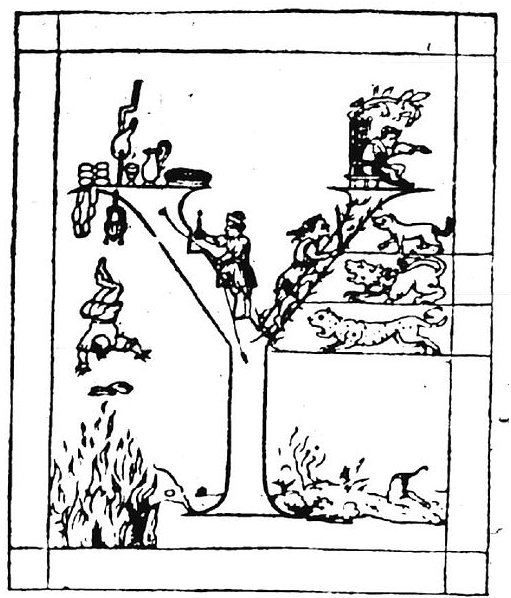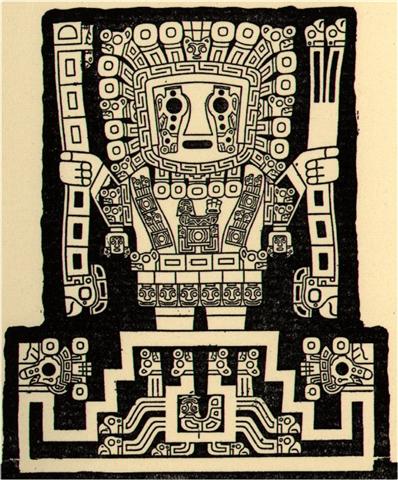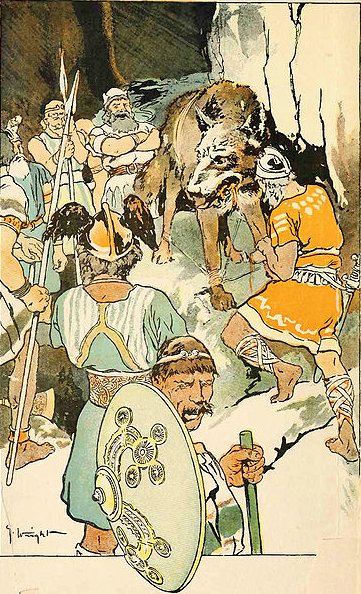Before doing so, however, I was struck by insight:
The Sun in the night - as I perceive this central figure standing like Osiris at the horizon in the west - has a pair of 'staffs' (or 'snakes'), divided by his hands. This looks like another way of presenting the same structural concept as in the pair of twin glyphs Gb4-13 and Gb4-14.
I.e., there was a pair of twin half cycles divided in pairs, described as staffs respectively as henua signs. Instead of visualizing how the bottom of henua was cut off from visibility by the surface of the earth the Sun god's equinoctial hands (with decapitated heads dangling at his elbows) could serve the same purpose. Below them there was no difference between left and right because any such difference would not be visible. But the top halves of the staffs was another matter. The staff in the Sun's left hand has a peculiar Y-form which I never was quite able to understand. But now I can see what it could have represented, viz. the diverging 'river branches' from the Tiamat twins to Anunitum respectively to Swallow. Winter time was in a way running withershins like the Moon:
... Ugallu was one of the eleven mythical monsters created by Tiamat [probably corresponding to Cetus] in her conflict with the younger gods, on the reverse of the first tablet of the Epic of Creation, Enûma Eli. The tale describes how Marduk captured and bound the creatures, rehabilitating them with work reconstructing the world from the corpses of his vanquished adversaries ... Marduk had overcome his enemies and bound (immobilized) the 11 Tiamat beasts of the previous cycle. This explains why Andromeda, the fishes in Pisces, Fenrir, and other such creatures were imagined as fettered:
The staff in the right hand of the nightside Sun has a single top hemisphere and there, I early decided, was the sky dome of high summer. In Gb4-13 the corresponding position has a greater mata than the rest. By the way, 41 * 3 (at Gb4-13) = 123 (= 333 - 210), a number we remember as a measure on side a of the tablet: ... By compressed I mean the number of glyphs from Ga2-27 (57) up to and including Ga7-10 (179) = 123 is much less than 365. But as if by coincidence 365 - 123 = 242 = number of glyphs on side b of the G tablet. And 471 - 123 = 348 = number of glyphs on side b of the C tablet:
The left hand of the Sun cycle holds the female side of the year, the time of births and ruled by Venus, Mira, etc. ... In the upper part of the façade [of a temple], as a pendant to the calabash on the right which represents the sun, it is a drawing of the moon, either full or as a crescent. This is a reminder, on the left-hand side, of the celestial regions. In the remaining space on the wall there are various ritual objects and animals in no particular order: the priest's forked staff, which is a symbol of both masculinity and femininity; the shaft itself, which is breast-high, is male, the female part is the fork in which the priest rests his forefinger, itself a symbol of the male ... The Swallow may have represented the new spirit of the high sky (rebuilt from Latarak) and Anunitum (reconstructed from Lulal) could have represented the abode of life on the earth below. ... 'The rays drink up the little waters of the earth, the shallow pools, making them rise, and then descend again in rain.' Then, leaving aside the question of water, he summed up his argument: 'To draw up and then return what one had drawn - that is the life of the world.' ... In spring the Sun sucks up water and then he returns it, creating a new cycle of life. The right staff of the Sun god terminated at high summer, where the sucking was complete (Omotohi).
... For they say that the course of human life resembles the letter Y, because every one of men, when he has reached the threshold of early youth, and has arrived at the place 'where the way divides itself into two parts', is in doubt, and hesitates, and does not know to which side he should rather turn himself´...  |
|||||||||||||||||||



